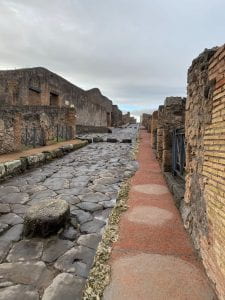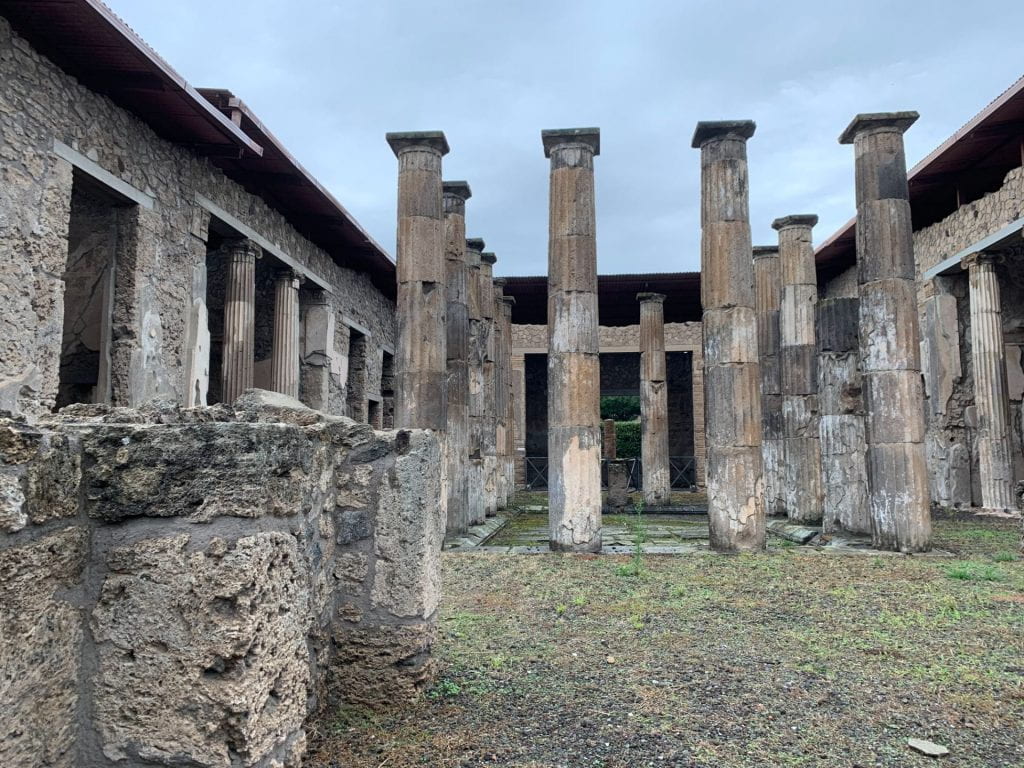Thursday, November 5, 2020 | Written by Kaela
POMPEII, ITALY
 Prior to the eruption of Mount Vesuvius in 79 AD, Pompeii was just another seaside Roman city. The explosion buried the city in ash, killing thousands of people, leaving it abandoned perfectly preserved until it was rediscovered by explorers in the 18th century. Pompeii is not a destination Georgia Tech-Lorraine students prioritize visiting as it’s a very long trip from Metz; however after my trip, I believe the amazingly preserved city should be on everyone’s bucket list.
Prior to the eruption of Mount Vesuvius in 79 AD, Pompeii was just another seaside Roman city. The explosion buried the city in ash, killing thousands of people, leaving it abandoned perfectly preserved until it was rediscovered by explorers in the 18th century. Pompeii is not a destination Georgia Tech-Lorraine students prioritize visiting as it’s a very long trip from Metz; however after my trip, I believe the amazingly preserved city should be on everyone’s bucket list.
We started our day in Pompeii at Alleria Pizzeria. I ordered my first Italian meal, a margherita pizza topped with fresh buffalo mozzarella. The flavor that emanates from three simple toppings is a classic and never ceases to amaze me. The buffalo mozzarella was both sprinkled on top and baked into the pizza, adding even more depth to the flavor. For dessert, we ordered deep fried dough balls topped with an abundant amount of Nutella and powdered sugar. As we left the restaurant full and happy, we strolled the streets under a light drizzle, making random pit stops at souvenir shops and street-side vendors. Luckily, the weather cleared up just as we approached the Pompeii ruins.  While the city of Pompeii may be frozen in time, our time to explore the preserved city was limited. We initially passed the ruins of the amphitheatre. I found myself comparing it to the one I visited in Trier, which had crumbled more becoming engulfed in the surrounding terrain. By comparison, this amphitheater was astonishingly well-preserved. Afterwards, we followed the tourist carved path to viewing boxes filled with artifacts found throughout the city. The fascinating collection included food scraps burnt by falling soot, weathered gold jewelry, cracked mirrors, shining gems, bronzed coins, and many more commonplace items that have become relics. In the structures, some of the murals, mosaic flooring, and kitchen stoves still remain. Other artifacts such as clay vases, plates, and bowls remained placed throughout various rooms as if time had just stopped.
While the city of Pompeii may be frozen in time, our time to explore the preserved city was limited. We initially passed the ruins of the amphitheatre. I found myself comparing it to the one I visited in Trier, which had crumbled more becoming engulfed in the surrounding terrain. By comparison, this amphitheater was astonishingly well-preserved. Afterwards, we followed the tourist carved path to viewing boxes filled with artifacts found throughout the city. The fascinating collection included food scraps burnt by falling soot, weathered gold jewelry, cracked mirrors, shining gems, bronzed coins, and many more commonplace items that have become relics. In the structures, some of the murals, mosaic flooring, and kitchen stoves still remain. Other artifacts such as clay vases, plates, and bowls remained placed throughout various rooms as if time had just stopped.
Throughout the various buildings throughout the city were not only the everyday objects of life in Pompeii, but plaster casts of the people of Pompeii preserved in the volcanic ash. In 1860, an archaeologist named Guiseppe Fiorelli discovered he could make casts of the slowly decomposing bodies by touching up any holes with plaster. Fiorelli and the volcanic ash preserved the position they made upon their death. The haunting figures remained in fetal position or standing, all covering their face to keep from inhaling the ash; Pompeii’s fleeting last moments forever encased in stone. We wandered along the main street and went into buildings as we saw them and ended up finding stairs that led to a view overlooking the city surrounded by beautiful mountains. We ended our time in Pompeii with a view of what started it all, the now sleeping Mount Vesuvius.
We wandered along the main street and went into buildings as we saw them and ended up finding stairs that led to a view overlooking the city surrounded by beautiful mountains. We ended our time in Pompeii with a view of what started it all, the now sleeping Mount Vesuvius.




